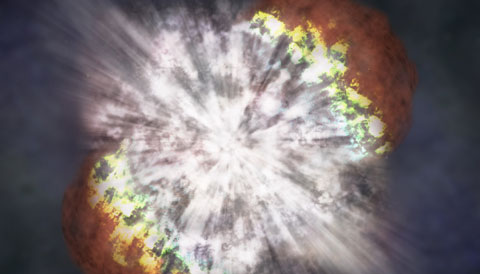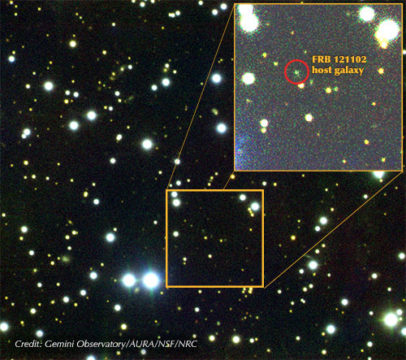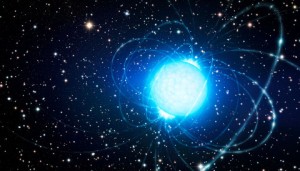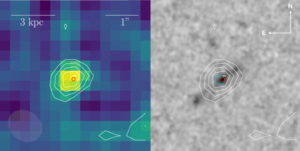What causes the bizarre, extragalactic fast radio bursts we’ve detected over the last decade? A new study of an unusually bright supernova may have found the key to answering this question.

NASA / CXC / M. Weiss
Clues from a Repeating Burst

Gemini Observatory / AURA / NSF / NRC
When a mysterious millisecond radio pulse of extragalactic origin — a fast radio burst (FRB) — was recently found to repeat, it gave astronomers a rare chance to hunt down this source’s host galaxy. FRB 121102 was isolated to a star-forming, low-metallicity dwarf galaxy located roughly 3 billion light-years away, and a dimmer, persistent radio source was discovered in the same region that produced the bursts.
This localization lent support to one theory for the origin of FRB 121102 (and possibly other FRBs): that the bursts are powered by a magnetized neutron star born decades ago in a superluminous supernova.
Magnetar Culprit?
Superluminous supernovae are a type of stellar explosion at least ten times more powerful than standard supernovae. These supernovae may shine extra bright due to the birth of a neutron star with extremely strong magnetic fields — a magnetar — that spins on millisecond timescales, emitting radiation and winds as its magnetic fields decay and further powering the explosion.

ESO / L. Calçada
In the superluminous-supernova explanation for FRBs, the magnetar born in the stellar explosion could, even a decade later, power brief radio bursts. In addition, it would generating a glowing nebula visible to us as a persistent radio source.
A team of scientists has now sought to test this picture by examining known superluminous supernovae and searching for signs of co-located persistent or bursting radio sources. In a recent publication led by Tarraneh Eftekhari (Harvard-Smithsonian Center for Astrophysics), they detail their first success.
Radio Source Found
Using the Very Large Array, Eftekhari and collaborators discovered a persistent radio source coincident with the superluminous supernova PTF10hgi, an explosion that went off 7.5 years ago, roughly 1.5 billion light-years away. This is the first time a radio source of any kind has ever been associated with a superluminous supernova, providing an important link between these explosions and other phenomena.

Eftekhari et al. 2019
The authors test a variety of different potential origins for the radio emission seen, like star formation activity, an active galactic nucleus, and a supernova blast wave. Though none of these scenarios can yet be ruled out with certainty, Eftekhari and collaborators show that each of them is highly unlikely.
Instead, the radio emission is extremely reminiscent of the persistent radio source associated with FRB 121102. The authors show that all of the observations are consistent with a magnetar central engine powering a glowing nebula embedded in the supernova ejecta. And while a bursting radio source wasn’t found coincident with the supernova, the authors’ observations were only 40 minutes long; a longer observation time may yet discover a co-located FRB.
The authors detail future observations that should be able to rule out alternative origins for the radio emission and strengthen the case for a superluminous-supernova-born magnetar as a source of fast radio bursts. In the meantime, it’s exciting to watch as the pieces of this puzzle start to come together!
Citation
“A Radio Source Coincident with the Superluminous Supernova PTF10hgi: Evidence for a Central Engine and an Analog of the Repeating FRB 121102?,” T. Eftekhari et al 2019 ApJL 876 L10. doi:10.3847/2041-8213/ab18a5
This post originally appeared on AAS Nova, which features research highlights from the journals of the American Astronomical Society.
 3
3









Comments
TorbjornLarsson
May 8, 2019 at 7:59 am
"In the meantime, it’s exciting to watch as the pieces of this puzzle start to come together!"
Copy that!
You must be logged in to post a comment.
Jim-Baughman
May 16, 2019 at 12:32 pm
I really wish you would include graphics that can be enlarged to a size decent for viewing. That used to be the case, but then perhaps a year ago the thumbnails began to lead to graphics that were barely bigger than the thumbnails. Now, in a further insult, in-post graphics that can be enlarged have been banished completely in favor of thumb-nail sized "illustrations".
What's the purpose of this image-stinginess? Why bother if all you are going to show is a postage stamp?
You must be logged in to post a comment.
Monica Young
June 25, 2019 at 5:03 pm
Thank you, Jim, we will be revamping the website soon and will keep your comments regarding image size in mind. In the meantime, a good workaround is to do ctrl+ (or cmd+ if on a Mac) to enlarge your screen.
You must be logged in to post a comment.
You must be logged in to post a comment.